A Buddhist Bhairava? Kṛtanagara’s Tantric Buddhism in Transregional Perspective
DOI:
https://doi.org/10.46586/er.13.2022.9653Keywords:
Pañjaranātha Mahākāla, Gur gyi mgon po, Bhairava, Mañjuśrī, Kṛtanagara, Kublai Khan, Ādityavarman, Tantric BuddhismAbstract
This article discusses some key aspects of the historical and religious background of the period of Kṛtanagara and his aftermath in East Java and Sumatra. Our analysis is based on a comparative study of Sanskrit, Old Javanese, and Tibetan textual sources and artistic vestiges (“medias”) to highlight the transregional networks of tantric Buddhism (“traditions”) that may have contributed to shape the king’s religio-political agenda. Having identified the enigmatic colossal statue at Padang Roco/Sungai Langsat in Dharmasraya (Central-Western Sumatra) as a Mahākāla bearing Śaiva iconographic contaminations, and as a product of Siṅhasāri-period East Java from Sino-Tibetan prototypes, we revive Moens’ (1924: 557) idea of an association between the icon and Kṛtanagara. Adding to the discussion on the Eastern Indian-style icon of Arapacana Mañjuśrī found near Candi Jago, we highlight further parallels that complement and fine-tune the idea advanced by previous scholars about the commonality of the tantric Buddhist paradigms practiced at the courts of Kṛtanagara and Kublai Khan, and propose that their legacy was adopted by the political elites of the subsequent generation in both Nusantara and China.
Published
Issue
Section
License
Copyright (c) 2022 Andrea Acri, Aleksandra Wenta

This work is licensed under a Creative Commons Attribution 4.0 International License.

